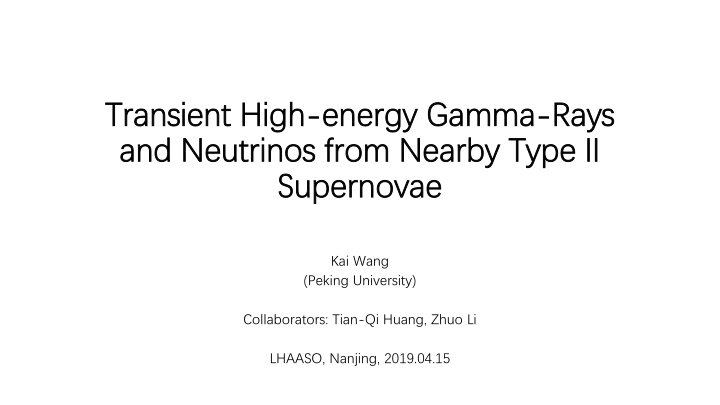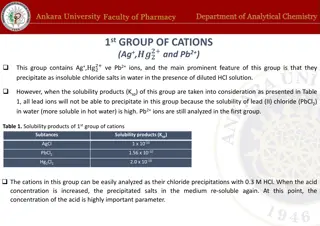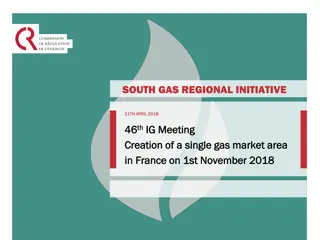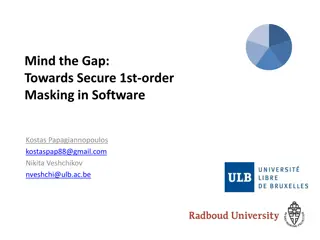
High-Energy Gamma Rays and Neutrinos from Supernovae
Explore the intriguing phenomena of high-energy gamma rays and neutrinos emitted during transient events such as supernovae. Learn about different types of supernovae, core collapse mechanisms, circumstellar mediums, and hadronic processes involved in producing these energetic particles. Discover the timescales and maximum proton energy associated with these events, shedding light on the interactions in the cosmos. Credit to researchers for their contributions to unraveling the mysteries of supernovae.
Download Presentation

Please find below an Image/Link to download the presentation.
The content on the website is provided AS IS for your information and personal use only. It may not be sold, licensed, or shared on other websites without obtaining consent from the author. If you encounter any issues during the download, it is possible that the publisher has removed the file from their server.
You are allowed to download the files provided on this website for personal or commercial use, subject to the condition that they are used lawfully. All files are the property of their respective owners.
The content on the website is provided AS IS for your information and personal use only. It may not be sold, licensed, or shared on other websites without obtaining consent from the author.
E N D
Presentation Transcript
Transient High Transient High- -energy Gamma and Neutrinos from Nearby Type II and Neutrinos from Nearby Type II Supernovae Supernovae energy Gamma- -Rays Rays Kai Wang (Peking University) Collaborators: Tian-Qi Huang, Zhuo Li LHAASO, Nanjing, 2019.04.15
Why are there different types ? Answer: progenitor stars are different Type II: collapse of Fe core in a normal massive star (H envelope) 2 possibilities: Type I: white dwarf accreted matter from companion collapse of Fe core in star that blew its H (or He) envelope into space prior to the explosion Ia: Ib,c
Core Collapse Supernova Core Collapse Supernova 103R core
Circumstellar medium Circumstellar medium 3 10 ( 3 -1 -1 /100km s ) yr M v M w Lasts for years Yaron+2017, NatPh
CSM interaction CSM interaction 1. Pre-shock CSM 2. Shocked CSM 3. Shocked ejecta 4. Unshocked freely expanding ejecta ? < ? ?? Credit to Nathan Smith
Hadronic processes With the radiation field Photomeson + 0 2 p + + + + , + + + + e e + + , e e Bethe-Heitler + + p e + + p e With the gas p-p collision + 0 p p
Timescales and Maximum Proton energy Timescales and Maximum Proton energy Wang et al., 2019, ApJ
High energy gamma High energy gamma- -rays and neutrinos rays and neutrinos LAHHSO? 1. Absorbed by thermal optical photons, CMB and EBL. 2. ~Week-scale transient at 2-3 Mpc for Fermi-LAT and CTA. 3. Few in ten years
Electromagnetic Cascades High energy gamma rays h Electron/positron pair production e e + + + Background radiation l + + e e Inverse Compton ...... e e Electromagnetic Cascades
Lower Lower- -energy non energy non- -thermal radiations thermal radiations Murase+2018
Lower Lower energy thermal Radiations energy thermal Radiations X X- -rays: rays: HMXT Balanced by coulomb heating and cooling processes EP Radio: Radio: Affected by free-free absorption, SSA, Razin Tsytovich process , Comptonization of thermal electrons
RB170817A RB170817A GW170817/G GW170817/G Photons GWs Multi Multi- -messenger messenger Astronomy Astronomy SN 1987A SN 1987A Blazar TXS 0506+056 Blazar TXS 0506+056 Neutrinos CRs
Fermi, HAWC, HESS, MAGIC, VERITAS CTA, SVOM, LHAASO HMXT, EP LIGO/Virgo LISA, Tianqin, Taiji GWs >=3 messengers? CRs IceCube IceCube Gen2, Km3Net. GRAND PAO, TA GRAND
Conclusions Conclusions A dense wind environment (or circumstellar medium) may be ubiquitous in regular Type II supernovae before explosion. for the SN 2013fs-like wind environment, multi-GeV and a few hundred TeV gamma-rays are detectable with a time window of ~week at <2-3 Mpc by Fermi-LAT and CTA. For a denser wind environment, the production of Neutrinos could be conspicuous above 300 TeV. LHAASO could detect such a transient for a distance of <~1Mpc, at least for a galactic event! Both high-energy and lower energy (Chinese devices? Early-stage observations) can be helpful to classify the nature of SNe. Searching early-stage Gamma-ray signals from nearby SNe Thanks for your attentions Thanks for your attentions






















